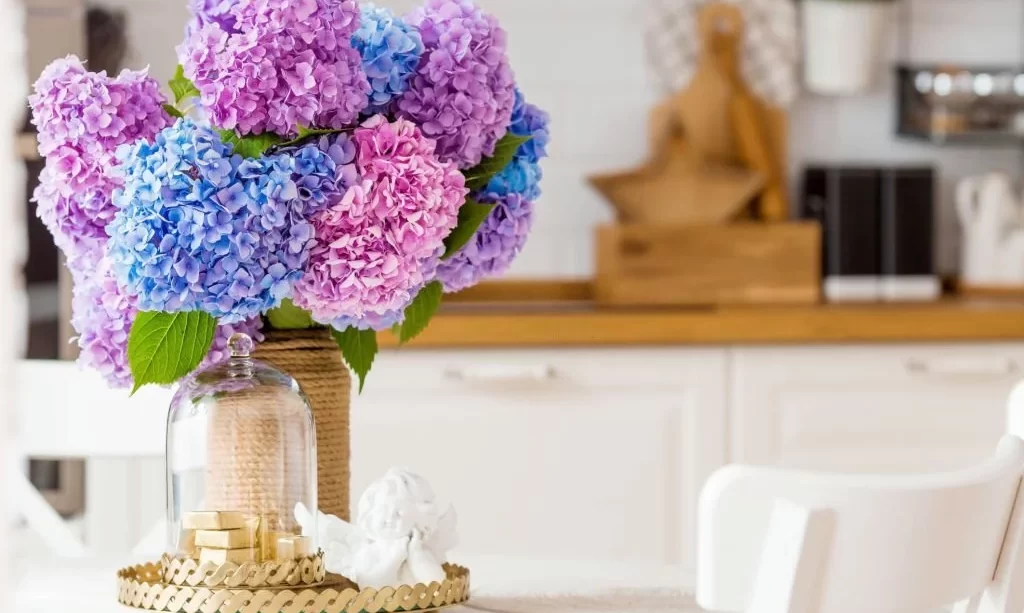Hydrangeas, with their magnificent and voluminous blooms, have long adorned gardens with their splendor. These ornamental shrubs are synonymous with outdoor landscapes, creating picturesque scenes with their lush clusters of flowers. Yet, the allure of hydrangeas doesn’t need to be confined to the outdoors alone. Have you ever wondered if you can bring the charm of hydrangeas inside your home? In this article, we embark on a journey to explore the world of growing hydrangeas indoors. While hydrangeas are typically cherished as outdoor plants, we’ll delve into the possibility of cultivating these beloved blossoms within the cozy confines of your home. So, let’s unlock the secrets of nurturing hydrangeas indoors and discover if these enchanting shrubs can thrive as indoor plants.
- Hardiness zone 4-9
- Sun to partial shade
- Mature size Height 3-4′ Width 4-5′
- 1 gallon
Hydrangeas
To begin our exploration into the world of indoor hydrangea cultivation, it’s crucial to understand the nature of these captivating shrubs. Hydrangeas belong to a diverse group of species and cultivars, each with its unique characteristics and requirements. In their natural habitat, hydrangeas are known for their ability to thrive in various climates and soil types, making them a favorite among gardeners worldwide. Typically, hydrangeas are grown outdoors, where they display their captivating blooms in gardens, landscapes, and as cut flowers in floral arrangements. These deciduous shrubs are renowned for their impressive flower heads, which can vary in size, shape, and color, depending on the hydrangea variety and soil conditions. Yet, can the beauty of hydrangeas be successfully harnessed indoors? To answer this question, we’ll delve into the intricacies of hydrangeas, their outdoor growth habits, and the unique care they require. Understanding these aspects is essential as we embark on the journey of growing hydrangeas within our homes.
Selecting Suitable Hydrangea Varieties
Not all hydrangeas are created equal when it comes to indoor cultivation. To embark on a successful journey of growing hydrangeas indoors, it’s essential to carefully select the right hydrangea varieties. Certain types are more conducive to thriving in indoor settings. Compact and smaller varieties, such as the ‘Penny Mac’ (Hydrangea macrophylla) or the ‘Tiny Tuff Stuff’ (Hydrangea serrata), are well-suited for indoor growing. These hydrangeas exhibit a more restrained growth habit, making them easier to manage in indoor containers. When selecting a hydrangea variety for indoor cultivation, it’s crucial to consider their size, adaptability to indoor conditions, and flowering habits. The right choice of hydrangea variety will play a pivotal role in the success of your indoor gardening venture, ensuring that your home is graced with the beauty of these captivating blossoms.
- Large blue or deep-lavender mophead flower balls smother this prolific bloomer
- A solid plant with strong stems, and small clear green, dentate leaves
- Bloom color varies greatly according to the soil pH
- Hydrangea macrophylla
Container Selection and Indoor Location
Growing hydrangeas indoors begins with the choice of containers and the placement within your home. Selecting suitable containers is crucial, as it impacts the health and growth of your hydrangeas. Opt for containers with proper drainage to prevent waterlogging, which can be detrimental to the roots. Consider pots or containers that are slightly larger than the root ball of your hydrangea, providing ample room for growth. When it comes to placement within your home, find a location that offers bright, indirect sunlight. Hydrangeas thrive in ample light but need protection from direct sun, which can scorch their delicate foliage. A well-ventilated area with consistent temperatures, typically between 60-70°F (15-24°C), is ideal for indoor hydrangeas. Proper container selection and finding the right spot in your home are essential steps in creating a conducive environment for your indoor hydrangeas to flourish and grace your living space with their exquisite blooms.
Soil and Planting
The foundation for successful indoor hydrangea cultivation lies in the choice of soil and the planting process. Hydrangeas thrive in well-draining soil that retains moisture without becoming waterlogged. A potting mix specifically formulated for flowering shrubs or hydrangeas is ideal. Ensure that the container has adequate drainage holes to prevent root rot, which can occur if excess water accumulates in the soil. When planting your hydrangea in the container, position it at the same depth it was growing in its original nursery pot. Gently pack the soil around the root ball and water thoroughly to settle the plant. Proper soil and planting techniques are fundamental to establishing a healthy foundation for your indoor hydrangea.
Indoor Hydrangea Care and Maintenance
Caring for indoor hydrangeas involves specific routines to maintain their health and encourage optimal growth. These routines include providing adequate sunlight, which is crucial for hydrangeas to produce blooms. Place your hydrangea in a spot with bright, indirect light. Maintain consistent humidity levels by misting the plant or using a humidity tray, as indoor environments can be drier than outdoor conditions. Water your hydrangea when the top inch of soil feels dry to the touch, but avoid overwatering, which can lead to root rot. Fertilize your indoor hydrangea with a balanced, water-soluble fertilizer during the growing season to provide essential nutrients. Regularly inspect your plant for any signs of pests or diseases, and take appropriate measures if issues arise. Pruning is also important, as it encourages bushier growth and removes dead or spent blooms. Proper care and maintenance are essential to ensure your indoor hydrangea thrives and graces your home with its lush foliage and vibrant blossoms.
Promoting Colorful Blooms Indoors
One of the delightful aspects of growing hydrangeas indoors is the potential to influence the color of their blooms. Hydrangea bloom color is determined by soil pH. For pink blooms, maintain slightly acidic soil with a pH of around 6.0, while blue blooms thrive in more acidic soil with a pH of 5.0 or lower. To achieve these colors, you can adjust the soil pH by using additives like aluminum sulfate for bluer blooms or lime for pinker blooms. Be mindful that these changes may take time to manifest in the hydrangea’s blossoms. Proper soil pH management allows you to enjoy a spectrum of colorful hydrangea blooms indoors, adding a vibrant touch to your indoor gardening experience.
- 7-3-3 Analysis – Great for promoting lush leaves and enhance and maintain blue color in many pink and blue varieties of hydrangeas.
- Many Ways to Feed – Hydrangea Blue can be used as a foliar or root feeding product. Great for spraying directly onto leaves, roots, or when used in a continuous feed system.
- Water-Soluble Powder – Powdered concentrates go further than liquid fertilizers. Simply mix your measured powder with water and you are ready to feed with multiple gallons of liquid fertilizer!
- Included Measuring Spoon – All Jack’s Classic fertilizers come with a convenient spoon to create the right amount of liquid fertilizer for your plants.
- Micronutrients – Added micronutrients supply your plant with the nutrition it needs for optimal growth and health. Unlike other fertilizers, additional feeding is not required.
Challenges of Growing Hydrangeas Indoors
While the prospect of indoor hydrangea gardening is enticing, it does come with its fair share of challenges. One of the primary challenges is replicating outdoor conditions within your home. Hydrangeas are accustomed to varying temperatures, humidity levels, and natural light cycles, which can be difficult to mimic indoors. Maintaining the right balance of light, humidity, and temperature can be challenging, particularly in regions with extreme weather conditions. Furthermore, indoor pests like aphids and spider mites can pose a threat to your hydrangeas. These challenges emphasize the importance of vigilance and regular care to ensure the health and vitality of your indoor hydrangeas. However, with dedication and proper care, many gardeners find the rewards of growing hydrangeas indoors well worth the effort.
Overwintering and Indoor Hydrangea Care
Overwintering indoor hydrangeas is a critical consideration, especially as colder months approach. As winter arrives, reduce watering gradually to allow your hydrangea to enter dormancy. Trim back any dead or yellowing foliage to promote dormancy. To protect your plant from cold drafts, keep it away from heaters, radiators, or cold windows. If your indoor hydrangea experiences a period of dormancy during the winter, it’s normal. During this time, water sparingly, as the plant’s metabolic processes slow down. When spring approaches and temperatures rise, resume regular watering and watch for signs of new growth. Proper overwintering and care ensure that your indoor hydrangea remains healthy and ready to grace your home with its beauty year after year.
Conclusion
In conclusion, the journey of growing hydrangeas indoors opens up a world of beauty and botanical wonder within the confines of your home. While it does present its unique challenges, the opportunity to enjoy the lush foliage and vibrant blooms of hydrangeas in your indoor spaces is a rewarding endeavor. Careful selection of suitable varieties, proper soil and planting techniques, and consistent care routines are key to success. By embracing the joys and challenges of indoor hydrangea gardening, you can create an oasis of color and elegance within your home, transforming it into a year-round garden that celebrates the charm of these beloved blossoms.







